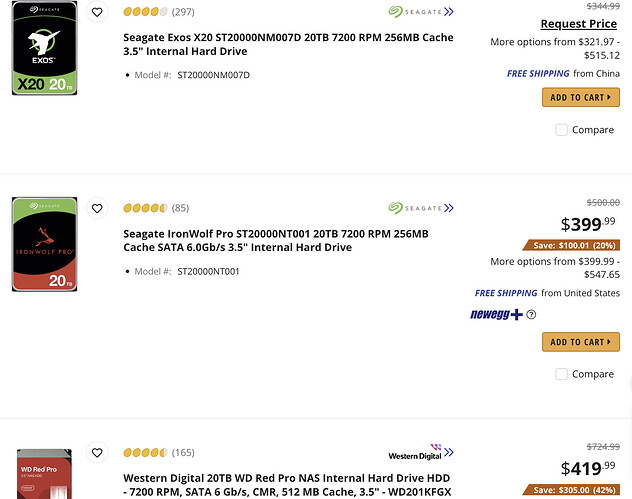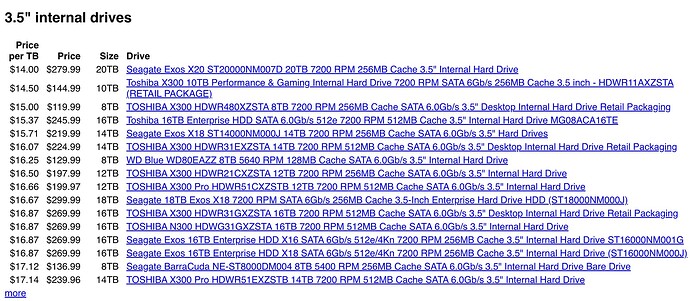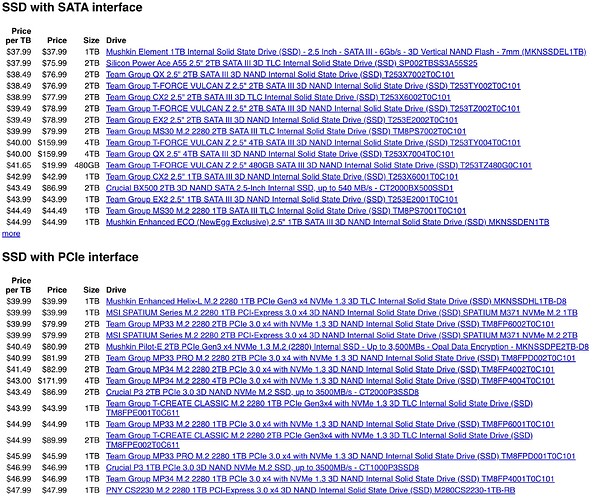And that nicely wraps up the case for consumer HA-/HM-SMR drives. Thanks, but no thanks.
I was just coming to ask that question after seeing the 16Tb Ironwolf pro drives are on sale at a pretty nice price in the UK, so thank you ![]()
On a related have there been any public road map releases about these new drives? I imagine IX need to be on top of that; if the major producers are forcing any new tech which clashes with ZFS it will have to be designed around and I only see that taking time…
Personally I see a couple of these drives in my future as a very size efficient back up system for replication…
Yeah the Mozaic drives are a different kettle of fish. They apparently appear as two independent drives to the OS so a whole new world of issues arrives with deciding how to use them.
I’ve recently gone to market and 24TB was as good as it gets atm for conventional CMR drives.
Are the Mozaic drives multi-actuator like the Exos 2X series? It doesn’t carry the same MACH.2 branding, so it might just be increased areal density.
It’s important to disambiguate between MA meaning “Microwave-Assisted” vs MA meaning “Multi-Actuator” - which I believe is part of the reason they went to HAMR (Heat-Assisted) as the abbreviation of choice there.
Ah perhaps I’m confusing the two then apologies.
It’s seems that 24TB was as big as I could get just recently so perhaps they’re not available to purchase in bulk just yet or the price is just ![]()
Agreed that if we’re only talking a difference of 2TB then best keep away from SMR at least for now.
I thought shingling was supposed to yield a 20% delta at best. To OEMs, that’s huge as it allows the potential deletion of a platter while costing virtually nothing. Hence WD doing its users dirty by surreptitiously shipping SMR drives while festooned with the traditional red NAS line sticker.
Does it have fewer spindles; is it dramatically cheaper?
I don’t disagree with the conclusion, but I agree that’s curious.
Exactly.
…where can you buy one?
Unless your name is Google, Amazon, Facebook or Microsoft, I don’t think you can…yet
I’d just be happy with better priced 20 TiB drives ![]()
Price per TB (edwardbetts.com)
It’s getting better, but still $10/TiB is a sweet spot that we haven’t seen yet.
But 4TiB SSDs have come down really far in price these days, which may be even more enticing, but we’re still like 1/8 the size for 4x the cost.
Hmm…
Theoretically you can get close to 100%, if all space is shingled. That of course is not practical because it implies needing to re-write an entire platter if you need to start at the wrong side. That is why they would use guard tracks between shingled groups to reduce the amount of re-write.
But, only 20%? I guess if it eliminates a platter, (and associated head, with electronics), it could be enough of a savings to be worth it to a vendor.
I am NOT however condoning what Western Digital did to their NAS Red line. That is unforgivable and unforgettable! But, I find it quite amusing that WD’s Web site page for NAS Reds is STILL broken after week;
https://www.westerndigital.com/products/internal-drives/wd-red-sata-hdd?sku=WD40EFAX
Here’s hoping the WD Reds die a miserable death!
The Wikipedia entry for SMR claims about 25% but like you said, it will depend on how many guard tracks you put down between sectors to retain at least some real world performance.
Reading that, I also found out that hardware-wise CMR vs. SMR are actually different because the write head is bigger for SMR than CMR.
But clearly SMR must be cheaper on a $/TB basis than CMR or WD wouldn’t have pulled the Red switcheroo stunt with its users.


